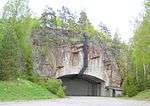Underground hangar

An underground hangar is a type of hangar for military aircraft, usually dug into the side of a mountain for protection. It is bigger and more protected than a hardened aircraft shelter (HAS).
An underground hangar complex may include tunnels containing the normal elements of a military airbase - fuel storage, weapon storage, rooms for maintaining the aircraft systems, a communications centre, briefing rooms, kitchen, dining rooms, sleeping areas and generators for electrical power.
Countries that have used underground hangars include Albania, China, India, Pakistan, Italy, North Korea, Norway, South Africa, Sweden, Switzerland, Taiwan, Vietnam and Yugoslavia.
By country
India
The Indian Air Force operates underground hangars. Sukhoi Su-30 MKI have been stationed at Trishul Air-base situated in Bareilly, Uttar Pradesh, India. It houses one of the largest underground hangars in Asia.
Hindon, situated in Uttar Pradesh, a 5 minutes flight from Delhi is the 8th largest in the world, with one of the most complex and massive underground hangars and facilities. It is the home base for C-130J, C-17 Globemaster and Mi-17.
Adampur, situated in Punjab, houses an air-base with underground hangars. It is the home base for MiG-29s.
Pakistan
Pakistan has an underground hangar facility for the Pakistan Air Force at PAF Base Mushaf, Sargodha, Punjab.
Sweden

In 1941 the Swedish Air Force began building its first underground hangar at F 9 Säve, located near Gothenburg in south-west Sweden, it was commissioned in 1943. After World War II plans were made up for building underground hangars at every air force base that had suitable rock conditions. These ambitious building plans proved to be too expensive and were reduced to hangars at certain selected air bases. A second underground hangar was built in 1947 at F 18 Tullinge which began operating in 1950. After that plans were finalized for building underground hangars capable of surviving close hits by tactical nuclear weapons. This required that these new hangars be much deeper, with 25 to 30 meters of rock cover, and heavy-duty blast doors in concrete. The Saab 37 Viggen aircraft was designed with a folding tail fin to fit into low hangars. The Aeroseum an aircraft museum open to the public in Gothenburg is housed in the larger cold war era Underground Hangar at Säve.
Switzerland
Six Flugzeugkaverne (aircraft caverns), each with space for 30 or more aircraft, were constructed for the Swiss Air Force. One is used to operate F/A-18 Hornet aircraft.
Yugoslavia
The largest underground hangar complex in former Yugoslavia was at Željava Airport near Bihać, with enough space for 80 MiG-21s. Slatina Air Base, located at Pristina International Airport, contained the second largest.
Taiwan
The only Taiwanese airbase with underground hangars is Jiashan Airbase, located in Hualien on the east coast of Taiwan, to guard against a massive missile strike launched from China. Underground hangars in Jiashan Airbase have deployed F-16 A/B and F-5 E-F squadrons.
Saudi Arabia
During the Gulf War, USAF and Saudi Air Force utilized underground hangars with good desert camouflage, and launched air raids against Saddam Hussein's air powers.
South Africa
South Africa has an underground hangar facility for the South African Air Force at Air Force Base Hoedspruit.
External links
| Wikimedia Commons has media related to Underground hangars. |
- Armeeschulfilm über die Schweizer Flugzeugkaverne
- "Underground Hangars to Protect War Planes" Popular Mechanics, September 1937
| Aircraft cavern | |
|
| |
|
| |
|
| |
|
| |
|
|